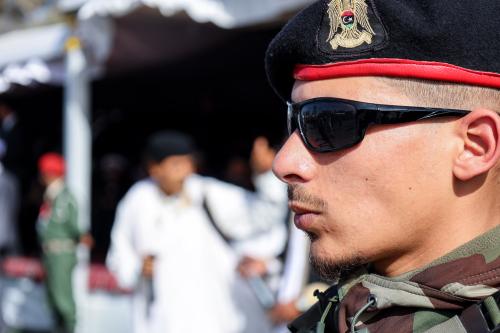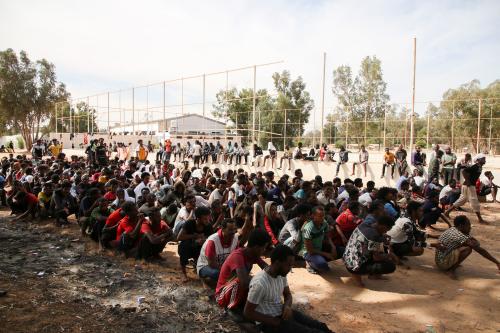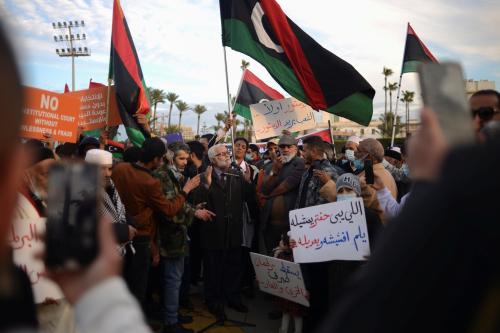This piece is part of a series titled “Nonstate armed actors and illicit economies in 2023” from Brookings’s Initiative on Nonstate Armed Actors.
In recent months, the administration of U.S. President Joe Biden has adopted a series of measures to respond to the record number of migrants and asylum-seekers at the U.S. southern border last year. This has included expanding the controversial Title 42 policy, which has been used by both the Trump and Biden administrations to expel migrants and asylum-seekers without asylum hearings on the grounds that doing so would prevent the spread of COVID-19. On January 5, Biden announced that the policy would be used to expel Cubans, Venezuelans, Nicaraguans, and Haitians to Mexico — groups whom Mexico had previously refused to accept. In exchange, the administration will admit up to 30,000 monthly asylum-seekers from Cuba, Venezuela, Haiti, and Nicaragua to the United States through humanitarian parole if they have financial sponsors and undergo vetting.
These policies appear to have reduced the number of Cubans, Venezuelans, Haitians, and Nicaraguans who crossed the U.S. border in January 2023 by over 95 percent compared to December; overall apprehensions were the lowest since February 2021. As the administration attempts to end Title 42 at the Supreme Court, it is also reportedly negotiating a deal with Mexico that would continue the parole process and allow the expulsion of non-Mexicans who attempt to cross illegally into the United States to ensure crossings do not increase after the policy ends. Yet while these policies may decrease crossing attempts in the short term, they also may have dire ramifications for both asylum-seeker rights and the rise of nonstate groups.
In addition to directly driving displacement from Central and South America, organized crime groups have exploited the increased migrant and asylum-seeker population in Mexico through exorbitant smuggling fees and kidnapping migrants for ransom and labor. Particularly in contexts with high levels of organized crime or where a central state does not have full territorial control, outsourcing migration management creates a growing, vulnerable population to be preyed upon. Aid to such countries for immigration and border enforcement may also indirectly contribute financial resources to nonstate groups with ties to state forces.
Nowhere has this been clearer than in Libya. Since 2015, European Union countries have directed hundreds of millions of dollars toward Libya to crack down on migrants and asylum-seekers attempting to reach Europe. The EU border agency, Frontex, has worked with Libyan authorities to force back tens of thousands of individuals since 2016.
Analysts and advocates have repeatedly demonstrated that the EU approach has empowered both state and “hybrid” militias to kill and torture migrants with impunity. They are also profiting from both EU aid and the migrants themselves. Furthermore, this approach may not have been effective beyond the short term, as crossings from Libya are rising once again.
The parallels between U.S. migration policy and the EU’s experience with Libya are not direct. Yet the effects of EU policy offer many lessons for crafting a U.S. approach to migration in the Americas. Cartels and crime groups are profiting handsomely in the smuggling business as a result of repeat crossing attempts enabled by Title 42. Reporters have written about cooperation between corrupt Mexican migration enforcement officials and smugglers. As Libya’s experience demonstrates, the Biden administration must seriously consider the consequences of its policies for asylum-seekers in countries already facing challenges in nonstate violence.
EU migration externalization
The EU and its member countries have increasingly tamped down on migration following a rapid uptick in asylum-seeker and migrant arrivals in 2014 and 2015. Key methods include cooperative agreements and aid to Libya and Turkey — two primary transit countries for individuals seeking to reach Europe.
In the case of Libya, EU assistance totaled over 700 million euros ($750 million in today’s rates) between 2014 and 2020. Most of this funding — approximately 455 million euros ($488 million in today’s rates) — went specifically toward migrant and asylum-seeker protection, host community stabilization, and border enforcement and management. This assistance has included funding for and services in migrant detention centers in Libya, training for the Libyan Coast Guard, and “voluntary” repatriation of migrants and asylum-seekers. In 2017, Italy signed a memorandum of understanding with the U.N.-recognized government to provide economic assistance and border security equipment in exchange for the Libyan Coast Guard intercepting migrant boats at sea.
As with the United States, this strategy initially seemed to have worked. Migrant and asylum-seeker arrivals through the central Mediterranean route (which includes Libya) declined from a peak of over 181,000 in 2016 to just 14,000 in 2019.
The role of nonstate groups in Libya
Yet the EU’s policies have come at a steep cost. In exchange for stemming migration, European leaders have overlooked atrocities committed by the Libyan state and hybrid groups against migrants and asylum-seekers. Humanitarian assistance has gone directly to programming in detention centers run by militias with ties to the state, who both abuse refugees and engage in human trafficking and smuggling. European migration externalization has both empowered these groups domestically and provided violent actors with international leverage by using migrants as bargaining chips.
In 2014, Libya devolved into a civil war in which disparate political factions backed by militias — chiefly the opposing Libyan National Army (LNA) led by Khalifa Haftar against the U.N.-recognized government — vied for control of the country. Though an internationally-backed cease-fire was implemented in 2020, it has not prevented Libya’s slide into misgovernance and abuses by state and hybrid actors against citizens and migrants.
Militias have profited from human trafficking, smuggling, and European policies. A host of reporters, human rights advocates, and analysts have documented militias’ control of and widespread abuses in detention centers receiving EU funding. For the thousands of migrants in Libya outside of detention centers, many are subjected to forced labor by militias. Analysts have argued that Europe’s approach has “normalized” militias as agents of migration control and provided them with a captive group to extort for additional funds.
Yet deep political aversion to additional migration has led Europe to continue funding migration enforcement and supporting collaboration between Frontex and the Libyan Coast Guard. Despite this, migration through Libya is rising again, driven by increases from eastern Libya which is controlled by Haftar’s LNA. Overall arrivals from the central Mediterranean route, including both eastern and western Libya, increased from 35,628 in 2020 to 105,561 by the end of 2022. However, the EU is responding with many of the same failed policies. On February 2, Italy renewed its agreement with Libya despite the latter’s human rights abuses.
Lessons for U.S. policy at the southern border
The EU’s experience with Libya has implications for U.S. migration policy in the Americas. In reaching the United States, migrants and asylum-seekers from Central and South America must cross numerous countries which are themselves key origin points for migrants and are grappling with varying levels of violence and political influence by organized crime groups, including drug cartels and gangs. Nonstate violence is a key driver of displacement from El Salvador, Guatemala, and Honduras in particular, as well as Haiti and other main migrant-sending countries across the region.
Upon taking office, Biden quickly took steps to improve migration policy in the region. His administration suspended Trump-era agreements with Honduras, El Salvador, and Guatemala which forced asylum-seekers arriving in the United States to seek asylum in these countries instead. However, the administration’s expansion of Title 42 enforcement — even as it attempts to end it in court — risks repeating the same mistakes of trapping migrants in unsafe conditions, especially in Mexico. To plan for the aftermath of Title 42, the administration has proposed a ban on U.S. entry for migrants and asylum-seekers who did not first seek asylum in the transit countries of Mexico and Panama. The deal it is reportedly negotiating with Mexico would also expedite deportations of non-Mexicans to Mexico even if they attempt to claim asylum if they cross illegally.
Under the Cartagena Declaration, Mexico has relatively generous asylum policies. Yet journalists and advocates have documented the growing risks of kidnapping and violence migrants and asylum-seekers face from cartels and criminal groups in Mexico. While armed groups in Mexico are not nearly as embedded with the state as militias in Libya, recent data leaks have revealed direct collusion between the military and drug cartels.
Regional cooperation in managing migration is key. But trading aid and political concessions for keeping migrants and asylum-seekers out not only violates the legal right to seek asylum but risks serious ramifications for the strength of armed nonstate groups in migrant transit countries. The United States has acknowledged the reality of a hemispheric increase in forced displacement produced by climate change, conflict, and massive inequality — as evidenced by its leadership on the 2022 Los Angeles Declaration on Migration and Protection and private and public funding initiatives. It must also lead on this issue by upholding the right to seek asylum. Creating safe migration pathways and dramatically expanding asylum processing capabilities are important and necessary steps. Ensuring careful oversight and rights-based conditionality of aid toward migration protection and state training programs in Mexico are also key.
Above all, the United States cannot implement migration policies that threaten to only magnify security challenges and rights abuses. As Libya demonstrates, these policies may come at dire human and security costs.
The Brookings Institution is committed to quality, independence, and impact.
We are supported by a diverse array of funders. In line with our values and policies, each Brookings publication represents the sole views of its author(s).








Commentary
US migration policy and nonstate groups: Lessons from Libya
February 15, 2023